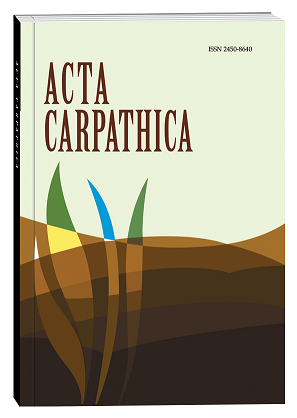BIO-INDICATION PERSPECTIVITY OF BETULA PENDULA ROTH. UNDER CONDITIONS OF ENVIRONMENTAL OIL POLLUTION
DOI:
https://doi.org/10.32782/2450-8640.2022.1.4Keywords:
Betula pendula, oil pollution, environment, bioindication, morphological indicators, physiological and biochemical indicatorsAbstract
The biological and ecological features of Betula pendula Roth. and its bioindicative perspectivity under the conditions of environmental oil pollution are analyzed. A wide areas of Betula pendula distribution are found both in the conditions of urbanized and natural territories of Ukraine, and in the natural zones of the Northern Hemisphere. The morphological, physiological and biochemical vitality indicators of the species under the oil pollution conditions are studied. The stability of the species linear foliar parameters and leaf area in the experimental area conditions are established, with the exception of the leaf asymmetry parameter, which doubles comparing to the background value. Peculiarities of Betula pendula assimilation organs necrotization under the influence of oil pollution are studied. It is found that the spotted type of necrosis is the dominant in the conditions of the background area, while "fish skeleton" and interveinal necrosis types are dominant in the oil deposit conditions. In the conditions of the background area, the necrotic lesions affect the smaller half of Betula pendula leaves, and at the same time, the largest number of leaves is affected by the second degree of necrosis. Under conditions of oil pollution 65% of the species leaf plates are affected by the fifth necrosis degree. This indicates that pollutants reach the plants above-ground organs through the root system. Under the influence of oil pollution there is a decrease in the buffer resistance of the species leaves’ cells internal environment relatively to the background values. Betula pendula reacts sensitively to an additional stress factor – acid rain, and restores buffer resistance by only 38.2%, while in the conditions of the background area this value is 55.8%. The most sensitive morphological bioindicative markers of Betula pendula vitality in the conditions of the environmental oil pollution are the fluctuating asymmetry coefficient and the leaves necrotic lesion degree. The parameter of buffer stability is characterized by the highest informativeness among other physiological and biochemical indicators. According to a complex of morphological, physiological and biochemical indicators, Betula pendula shows an average sensitivity to environmental oil pollution and can be used as a biological indicator of the ecological state of man-made territories.
References
Birke M., Rauch U., Hofmann F. Tree bark as a bioindicator of air pollution in the city of Stassfurt, Saxony-Anhalt, Germany. Journal of Geochemical Exploration. 2018. Vol. 187. P. 97–117. https://doi.org/10.1016/j.gexplo.2017.09.007
Franiel Izabella., Kompała-Bąba Agnieszka. Reproduction strategies of the silver birch (Betula pendula Roth) at postindustrial sites. Scientific Reports. 2021. Vol. 11, No 11969. P. 1–12. DOI: 10.1038/s41598-021-91383-0
Glibovytska N. I., Mykhailiuk Yu. M. Phytoindication research in the system of environmental monitoring. Науково-практичний журнал «Екологічні науки». 2020. Vol. 28. P. 111–114. https://doi.org/10.32846/2306-9716/2020.eco.1-28.16
Kicińska A. J. Arsenic, Cadmium and Thallium Content In Plants Growing In Close Proximity to a Zinc Works – Long-Term Observations. Journal of Ecological Engineering. 2019. Vol. 20(7). P. 61–69. doi:10.12911/22998993/109866.
Krišāns O., Matisons R., Vuguls J., Rust S., Elferts D., Seipulis A., Saleniece R., Jansons Ā. Silver Birch (Betula pendula Roth.) on Dry Mineral Rather than on Deep Peat Soils Is More Dependent on Frozen Conditions in Terms of Wind Damage in the Eastern Baltic Region. Plants. 2022. Vol. 11(9). 1174 p. https://doi.org/10.3390/plants11091174
Lewis J., Qvarfort U., Sjöström J. Betula pendula: A Promising Candidate for Phytoremediation of TCE in Northern Climates. Int. J. Phytoremediation. 2015. Vol. 17. No 1–6. P. 9–15. https://doi.org/10.1080/15226514.2013.828012
Łukowski A., Popek R., Karolewski P. Particulate matter on foliage of Betula pendula, Quercus robur, and Tilia cordata: deposition and ecophysiology. Environ Sci Pollut Res. 2020. Vol. 27. P. 10296–10307. https://doi.org/10.1007/s11356-020-07672-0
Pavlović D., Pavlović M., Marković M., Karadžić B., Kostić O., Jarić S., Mitrović M., Gržetić I., Pavlović P. Possibilities of assessing trace metal pollution using Betula pendula Roth. leaf and bark – Experience in Serbia. Journal of the Serbian Chemical Society. 2017. Vol. 82(6), P. 272–276. https://doi.org/10.2298/JSC170113024P
Pedroso A., Bussotti F., Papini A., Tani C., Domingos M. Pollution emissions from a petrochemical complex and other environmental stressors induce structural and ultrastructural damage in leaves of a biosensor tree species from the Atlantic Rain Forest. Ecological Indicators. 2016. Vol. 67. P. 215–226. https://doi.org/10.1016/j.ecolind.2016.02.054
Petrushkevуch Y. M., Korshуkov I. I. Ecological and biological characteristics of Betula pendula in the conditions of urban environment. Regulatory Mechanisms in Biosystems. 2020. Vol. 11(1). Р. 29–36. https://doi.org/10.15421/022004
Petrushkevich Y., Korshykov I. Morphological and physiological characteristics of the Betula pendula Roth pollen in Kryvyi Rih city conditions. Plant Introduction. 2018. Vol. 79. P. 58–66. https://doi.org/10.5281/zenodo.2278317
Rudenko S. S., Kostyshyn S. S., Morozova T. V. General ecology. Practical course: teaching study guide for students of higher education. Part 2. Natural terrestrial ecosystems. Chernivtsi. 2008. 320 p.
Shevchyk L. Z., Romanyuk O. I. Analysis of biological methods of recovery of oilcontaminated soils. Scientific Journal ScienceRise: Biological Science. 2017. Vol. 1(4). P. 31–39.
Yatsyshyn T., Glibovytska N., Skitsa L., Liakh M., Kachala S. (2020). Investagation of Biotechnogenic System Formed by Long-term Impact of Oil Extraction Objects. Systems, Decision and Control in Energy I, Studies in Systems, Decision and Control. 2020. Vol. 298. P. 165-177. DOI: 10.1007/978-3-030-48583-2_11
Yatsyshyn T., Lyakh M., Orphanova M., Glibovytska N., Gavryliv S., Liakh V. Decisions to prevent pollution and restore the environment within the abandoned oil and gas wells. IOP Conference Series: Earth Environmental Science. 2022. 1049 012017. 11 p. doi:10.1088/1 755-1315/1049/1/012017
Yusypiva T., Zadesenets A., Karas A. Variability of morphometric characteristics of Betula pendula lamina under technogenic conditions of Dnipro city. Ecology and Noospherology. 2019. Vol. 30(2). P. 68–73. https://doi.org/https://doi.org/10.15421/031912
Ziemianin M., Waga J., Czarnobilska E. Changes in qualitative and quantitative traits of birch (Betula pendula) pollen allergenic proteins in relation to the pollution contamination. Environ Sci Pollut Res. 2021. Vol. 28. P. 39952–39965. https://doi.org/10.1007/s11356-021-13483-8








